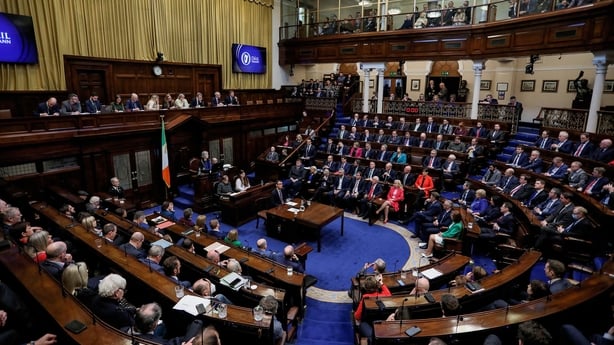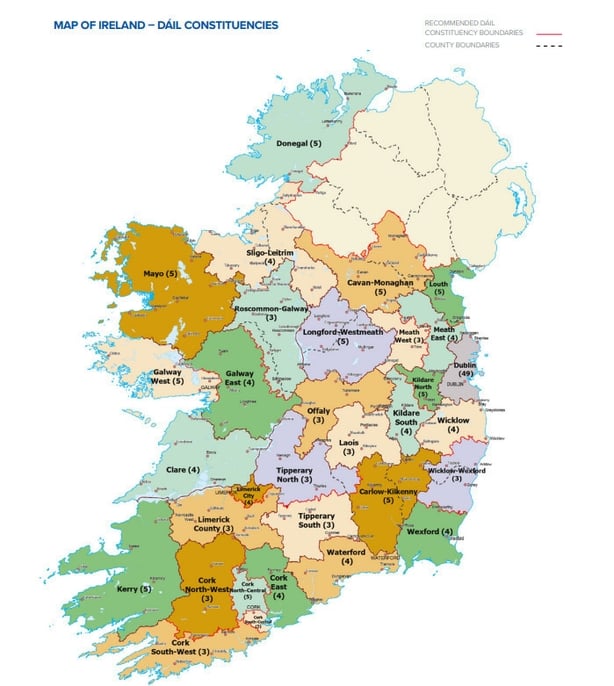The Electoral Commission has recommended that the number of TDs for the next Dáil be increased from 160 to 174.
In a widespread review of constituencies, the commission has also made a series of changes to boundaries and increased the number of constituencies from 39 to 43.
The review takes account of an 8% growth in the population since 2016.
Under the Constitution, Ireland should have one TD per 20,000-30,000 people.
Based on the current Dáil of 160 deputies, Ireland is already operating well beyond that with a national average of one TD per 32,182.
The recommendations announced today mean that each deputy would represent an average of 29,593 people.

The commission proposes a new inter-county constituency of Wicklow-Wexford to take in south Wicklow and north Wexford including Rathdrum, Avoca and Arklow in the north, Tinahely and Bunclody to the west, and Gorey, Ferns and Kilmuckridge to the south.
It calls for three constituencies to be split in half: Tipperary, Dublin Fingal and Laois-Offaly, each creating two three-seaters.
There are also additional new seats proposed in Mayo, Galway East, Kildare North, Longford-Westmeath and Meath East.
The commission had the option of recommending an additional 21 TDs.
However, during the course of its deliberations, it found that a higher number of deputies would "not result in coherent constituencies".
The report says this would result in a marked reduction in five-seat constituencies and an increase in the number of three-seat constituencies.
Speaking at the launch of the report, Chair of The Electoral Commission, Supreme Court Justice Marie Baker, said that a higher number of TDs would have resulted in a "huge amount of boundary changes".
Commission Chief Executive Art O’Leary said it would have resulted in the creation of a "vast number of three-seater constituencies".
"That would have resulted in a very skewed landscape if that was the case," he said.

Some of the smaller political parties had called for the creation of more four- and five-seater constituencies as these can favour smaller parties and independents.
The quota in a three-seater constituency is 25% and this can benefit larger parties and independents.
Overall, it is recommended that the number of three-seat constituencies would increase from nine to 13, there would be 14 four-seaters (down two) and 15 five-seat constituencies (up two).
The commission was asked to try - where possible - to keep county boundaries intact but admits this has not always been possible, adding that there were a high number of submissions on this in the public consultation phase.
Under the proposals, seven boundary breaches would be removed, but three new ones would be created.
Seven constituencies are set to remain unchanged: Clare, Cork South-West, Donegal, Dublin Central, Kerry, Limerick County and Waterford.
Under the Constitution, the ratio of TDs per head of population has to be within one per 20,000-30,000 people.
Mr O'Leary admitted that it was a "big call" to allow a variance of plus or minus 8% around the country.
Ms Justice Baker said that "absolute mathematical parity could not be done but has been done in so far as is practicable".
She described the review - as published - as delivering the "most coherent and clean constituencies" and one that "best reflects the electoral mandate".
The report's recommendations are being forwarded to the Houses of the Oireachtas who will determine the constituencies for both the Dáil and the European Parliament.
Read more:
Parties evaluate winners and losers in constituency review
Live: Constituency changes due to 8% increase in population
Number of TDs could rise by 21 after boundary report
TDs anxiously await commission report
The commission's remit allows for research on issues related to the "protection and enhancement of democracy".
Ms Justice Baker confirmed that it will now undertake some research in two specific areas.
The first will be on the ratio of TDs to the general public.
There were a number of submissions on this issue in the public consultation phase and the chair said: "If the population continues to increase at the current rate, the Dáil will become very large indeed."
The second area of research will focus on whether there should be six-seat constituencies in the future.
Both pieces of research will be carried out over the next few months.
The commission will also consider any necessary boundary changes to European Parliament constituencies once a final decision is made on how many extra seats that Ireland will be given.
If an EU decision is reached and a change is required, the commission will begin a month-long consultation period on this.






